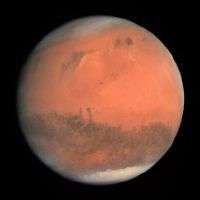Features of early Martian environment and presence of water drive search for life forms

New Rochelle, April 16, 2009-Solar energy and winds, collisions with asteroids and comets, and changing magnetic fields have all altered the environment of Mars, a planet that may have been able to support life during its history, as documented in a special collection of papers published in the current issue of Astrobiology, a peer-reviewed journal published by Mary Ann Liebert.
Compiled by Helmut Lammer, PhD, Senior Editor of Astrobiology, from the Austrian Academy of Sciences, this special paper collection features a report by Pham et al. that presents a semi-analytical model to evaluate the influence of impacts on the evolution of the carbon dioxide-based martian atmosphere. The results of this study indicate that impacts alone cannot satisfactorily explain the loss of significant atmospheric mass since the Late Noachian (~ 3.7 - 4 Ga). In other words, if the martian atmosphere was much denser at about 4 Ga than at present, impact erosion was most likely not responsible for the removal of the atmosphere at that time.
Terada et al. present a 3-D model to assess the effects of exposure to solar energy and winds on ion escape on early Mars 4.5 Ga, and to demonstrate how ion erosion could have led to the loss of water that might have been present on Mars. Two reports, by Horváth et al. and Fendrihan et al., explore the existence and survival of two types of bacteria under martian surface and environmental conditions, and the types of habitats that might have existed to support these life forms.
"The results of Pham et al. and Terada et al. indicate that Mars should have lost its denser initial CO2 atmosphere very early," says Dr. Lammer, PhD, "and may have been cold and dry during most of its history. Leblanc and colleagues propose a new concept in exploratory missions with Mars Environment and Magnetic Orbiter (MEMO), which would gather data to help scientists understand how the martian surface, atmosphere, and magnetic field have evolved, and how those questions raised by Terada et al. and Pham et al. can be investigated."
In honor of the bicentenary of the birth of Charles Darwin in 2009 and the anniversary of the publication of his seminal work, On the Origin of Species, this issue of Astrobiology also includes papers describing the proposed Darwin Mission, which will take measurements on Earth-like planets outside our solar system.
"Though the final configuration of missions to study the spectra of Earth-like planets has not yet been decided," says Charles S. Cockell, PhD, Senior Editor of Astrobiology, and Professor at The Open University, Milton Keynes, UK, "Darwin represents a very important step in a consolidated scientific and technical architecture for such a mission."
More information: This Special Paper Collection is available free online at www.liebertpub.com/ast
Source: Mary Ann Liebert


















